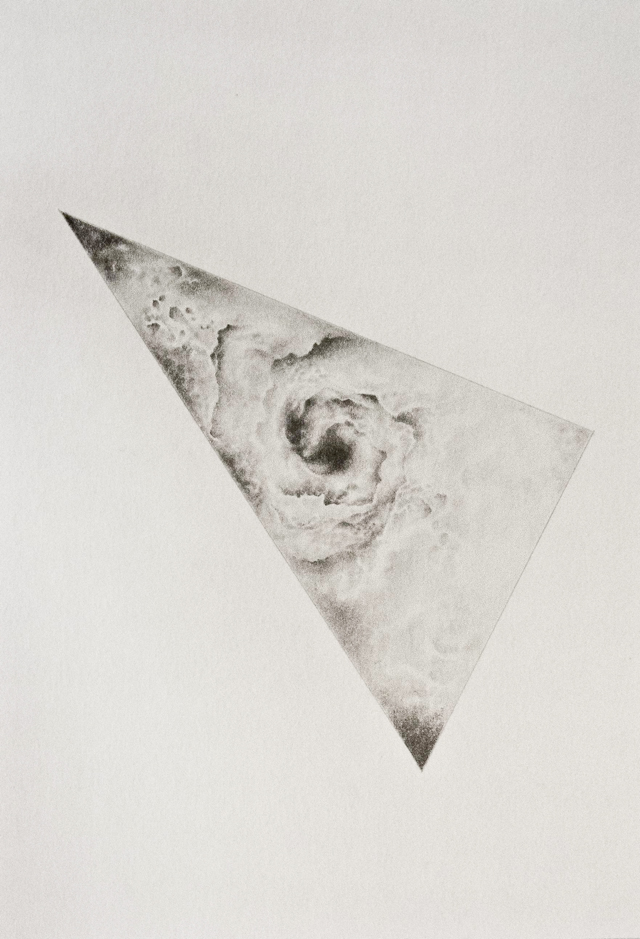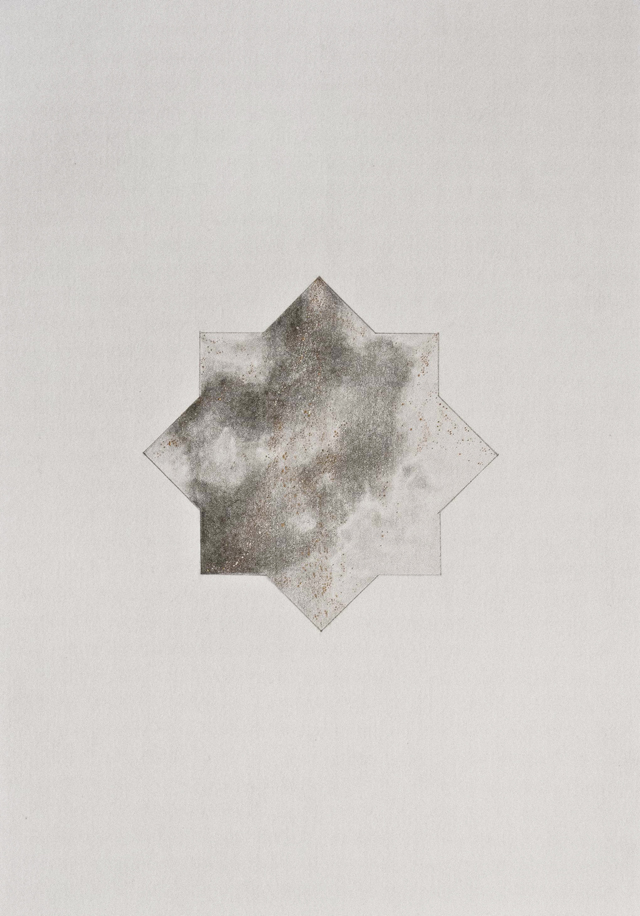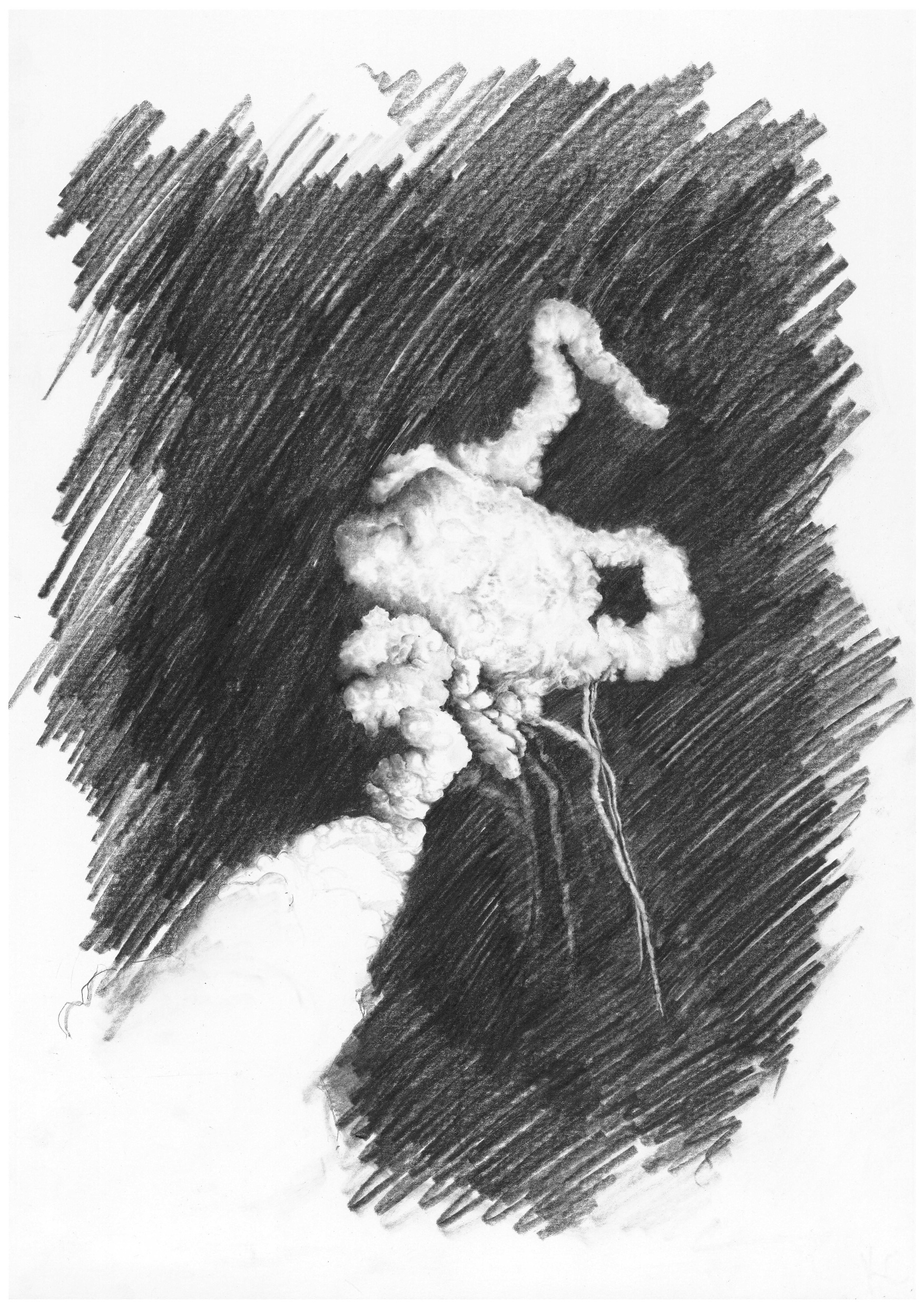Katy Cole
Interview by Rebecca Travis
Published October 2015
-
Katy Cole's work tackles subjects of incredible magnitude but manages to compress them into tameable forms. By transforming subjects such as intergalactic exploration into palatable formats she aims to uncover the human and ethical implications of such activities. She is currently a studio holder at the NewBridge Project and is currently working towards a solo exhibition at 36 Lime Street in Newcastle.
-

Postcard made during Venice residency, 2014
Your work both past and present frequently references scenes of explosive disaster, why the focus on this subject matter?
Over time I became increasingly aware of the bombardment of violent imagery we are subjected to in the media - from scenes of war to disasters of nature and human error - and of the seemingly rising global and social collective thought process, or panic, surrounding these reports.
Discerning an element of beauty inherent in these captured moments of catastrophe, I began re-appropriating chaotic imagery in an attempt to subvert the power of destruction into creative means.
By reinterpreting the aesthetic of such material through drawing and painting its meaning can become altered, even lost. It becomes an ambiguous form, often adopting a sense of calm at odds with the original context. I aim to illustrate something of the cyclical nature between chaos and control, construction and destruction.
Wall collage installation, They Used to Call it the Moon, BALTIC Centre for Contemporary Art, Photo John Mckenzie

Wall collage installation, They Used to Call it the Moon, Baltic39, Photo Colin Davison
Much of your practice is rooted in drawing, what attracts you to working with what could be considered the most simple of art mediums?
Drawing has always been the essential basis to my work, although I find it enjoyable and frustrating in equal measure. The intricacy of my current drawings began as a way of assigning myself exercises in focus and self-discipline. As an easily distracted person, past works have been left unfinished or subjects abandoned for new ideas all too frequently.
For me, the process of making is as critical as the subject matter or the finished article - this extends to the paintings and collage too. It is important to me to make all my work by hand. This can be time consuming, laborious, and at times a little obsessive! It comes down to a determination to learn a new way of working - and to create something that works.

M31, pin prick drawing, 2015
Can you detail the way that your work has evolved into collage installations? Such as the one recently exhibited at BALTIC Centre for Contemporary Art…
I had worked with collage in the past but was recently inspired to revisit it after a residency in Venice last year. As a tourist complete with a camera myself, I spent a lot of time bemusedly observing the behaviour of other tourists, traipsing around in matching neon rain macs, and viewing every aspect of the city from behind the lens of a camera (often complete with selfie stick). Drawing on this, I created a series of alternative postcards that combined the destructive imagery I had been using in my drawings with tourist scenes. The unsuspecting tourists riding in Gondolas and enjoying the carnivale seem blissfully unaware of the impending disaster heading their way.
More recently, and particularly in the shows at Baltic39 and BALTIC (two iterations of the group exhibition They Used To Call it the Moon), the collage has taken a sci-fi angle. Collages combining images of tourism and galactic landscapes again offer visions of tiny people, trekking from attraction to attraction, blindly taking selfies whilst inconceivable, turbulent scenes unfold before them in the enormity of the cosmos. By traversing science fact and fiction I am exploring contemporary thoughts towards space travel, and colonisation.

Doradus, graphite on paper, 2015

Cygnus, graphite and acrylic on paper, 2015

Antares, graphite and acrylic on paper, 2015
Where does the imagery for your collage works originate?
Predominantly from National Geographic magazines. I have an ever-increasing collection of hundreds of issues dating from the 1940's to present day. Also from internet searches, newspapers and second hand books. I find the vintage magazines featuring 'visions of the future' to be the most interesting, and surprisingly often quite correct.
How did the transition from working with earthly imagery to outer space imagery occur?
It seemed like a natural progression given that I have a longstanding, fundamental interest in natural phenomena. A lot of the source material I was viewing contained articles and imagery of space. I drew parallels with the scenes of disasters that I was already appropriating and these incredible images of hostile unexplored environments. The possibilities of the subject are endless, concerning both science fact and fiction. This gave me licence to imagine both actual and fantastical possibilities, interjecting elements of myth or fiction into real and hypothetical physical environments, and embodying themes such as Astronomy, Meteorology and Geology.

Galaxias, acrylic on plywood
Do you see your work as critical of man’s engagement with space?
Yes and no. I’m impressed and fascinated by the developments in knowledge of our wider surroundings, and the incredible wealth of high quality imagery made available to us. However, there is also immense danger involved - from the disastrous shuttle programme, to the ISS constantly at risk of being hit by the orbiting debris that we have littered space with, to more recent horrors such as The Virgin Galactic crash in October 2014. A current drawing depicts the Spacex Falcon 9 (Spacex whose ‘ultimate goal is to allow people to live on other planets) rocket exploding shortly after it was launched. We still have a long way to go.
I’m also not sure you can justify the amount of money spent on research into colonising space when our own planet and people are in a pretty poor state. Then there is the question of the ethics and motivation behind the exploration – is it right to exhaust the resources on our own planet and then move on to do the same elsewhere?
Can you speak about the play of scale within your works?
The works throughout my practice, from the explosions to the nebulas, take events of unimaginable magnitude and scale them down to a domestic size. A huge, hostile environment can be rendered into palm sized objects or delicate drawings. The intention is to familiarise a tiny fragment of the unknown, completely alter its context, humanise it.
Galaxies, acrylic on plywood, 2014
This seems particularly true of your ‘Galaxias’ series, in which galaxies are meticulously painted onto building blocks and geometric forms…
Yes, they literally take something of unfathomable size and pull them back to a contained and graspable scale. The formation and scale of that series is something I’m still experimenting with. Initially they were more or less palm-sized, then for the exhibition at BALTIC I produced one much larger and multi-sided ‘Galaxias’ work. Now for the exhibition at 36 Lime Street I am significantly reducing the scale again, so that they are really quite tiny, less than a cm square.

Galaxias, mixed media, 2013-15

Galaxias, mixed media, 2013-15
What form will the other works in your upcoming solo exhibition take?
I’m working on a pin prick drawing that will be illuminated from behind with film footage from the NASA archives to reveal star-scapes that shimmer and change as one approaches and moves away from the piece. There’ll be new drawings and a site-specific collage too.

Challenger, graphite on paper
Do you have a title in mind for the exhibition? And can you speak a little about how you go about naming your works generally?
A title I am considering is 'We ran as if to meet the moon' from the poem ‘Going for Water’ by Robert Frost which implies our increasing urgency to make inroads into space voyage, tourism and habitation. I often name works using quotes from dystopian science fiction literature, film or historic events in space exploration. I tend to note and collect quotes and ideas as I come across them, much like the collective process I employ with found imagery for my collage and drawing works.
-
Katy Cole is an artist based in Newcastle-Upon-Tyne. She has exhibited throughout the North East at venues including BALTIC Centre for Contemporary Art, Baltic 39, the Literary & Philosophical Society and the Great North Museum. In 2012 her work was also included in the Frieze week exhibition at Bow House (London). She has exhibited internationally as part of the 2013 VII Biennale di Soncini a Marco (Italy) and in 2014 was one of four artists internationally selected for the Generator residency in Venice.
Katy Cole’s solo exhibition at 36 Lime Street opens October 16
http://katycole.co.uk/
-
If you like this why not read our interview with Oliver Braid
-
© 2013 - 2018 YAC | Young Artists in Conversation ALL RIGHTS RESERVED